Finding the perfect hairstyle that adds volume, movement, and vitality to thin fine hair can feel like an overwhelming challenge, especially after turning 50 when hair texture naturally changes.
The good news is that medium length haircuts offer the ideal canvas for creating the illusion of fuller, thicker hair while maintaining versatility and elegance.
This comprehensive guide explores over 30 stunning medium length hairstyles specifically designed for women over 50 with thin fine hair, covering layered cuts that boost volume, textured styles that add dimension, strategic coloring techniques that enhance depth, and styling methods that maximize body.
Whether you’re looking for low-maintenance options or glamorous statement styles, you’ll discover practical solutions complete with styling tips, product recommendations, and professional insights that will transform your thin fine hair into a crowning achievement you’ll love.
Contents
- 1 1. Layered Bob with Side-Swept Bangs
- 2 2. Textured Shag with Choppy Layers
- 3 3. Blunt Lob (Long Bob) with Subtle Layers
- 4 4. Wavy Medium Length Cut with Volume at Crown
- 5 5. Angled Bob with Longer Front Pieces
- 6 6. Shoulder-Grazing Cut with Face-Framing Layers
- 7 7. Layered Cut with Curtain Bangs
- 8 8. Razored Medium Cut with Piece-y Texture
- 9 9. Collarbone-Length Cut with Internal Layers
- 10 10. Medium Shaggy Cut with Wispy Ends
- 11 11. A-Line Bob with Graduated Layers
- 12 12. Tousled Midi Cut with Beachy Waves
- 13 13. Layered Cut with Swoopy Side Bang
- 14 14. Textured Lob with Undone Ends
- 15 15. Layered Flip with Outward Ends
- 16 16. Asymmetrical Medium Cut with Longer Side
- 17 17. Wavy Bob with Piecey Layers
- 18 18. Medium Shag with Feathered Bangs
- 19 19. Shoulder-Length Cut with Balayage Dimension
- 20 20. Textured Medium Cut with Root Lift
- 21 21. Angled Lob with Razored Ends
- 22 22. Layered Cut with Highlights and Lowlights
- 23 23. Tousled Medium Length with Dry Texture
- 24 24. Collarbone Cut with Curved Layers
- 25 25. Messy Bob with Intentional Imperfection
- 26 26. Medium Length with Soft Graduated Bob
- 27 27. Choppy Medium Cut with Multiple Lengths
- 28 28. Wavy Lob with Middle Part
- 29 29. Textured Cut with Piecey Crown Layers
- 30 30. Shoulder-Length with Side-Swept Volume
- 31 31. Layered Cut with Babylights Throughout
- 32 32. Medium Shag with Front-Focused Layers
- 33 33. Collarbone Cut with Flicked-Out Layers
- 34 34. Asymmetrical Lob with Textured Styling
- 35 35. Medium Cut with Root-to-Tip Highlights
- 36 Essential Styling Products for Thin Fine Hair Over 50
- 37 Professional Styling Tips from Expert Hairstylists
- 38 Hair Care Routine for Maintaining Volume and Health
- 39 Lifestyle Factors That Affect Hair Health Over 50
- 40 Choosing the Right Stylist for Fine Hair
- 41 Budget-Friendly Alternatives to Salon Treatments
- 42 Adapting Your Style for Different Occasions
- 43 Embracing Gray Hair with Style
1. Layered Bob with Side-Swept Bangs
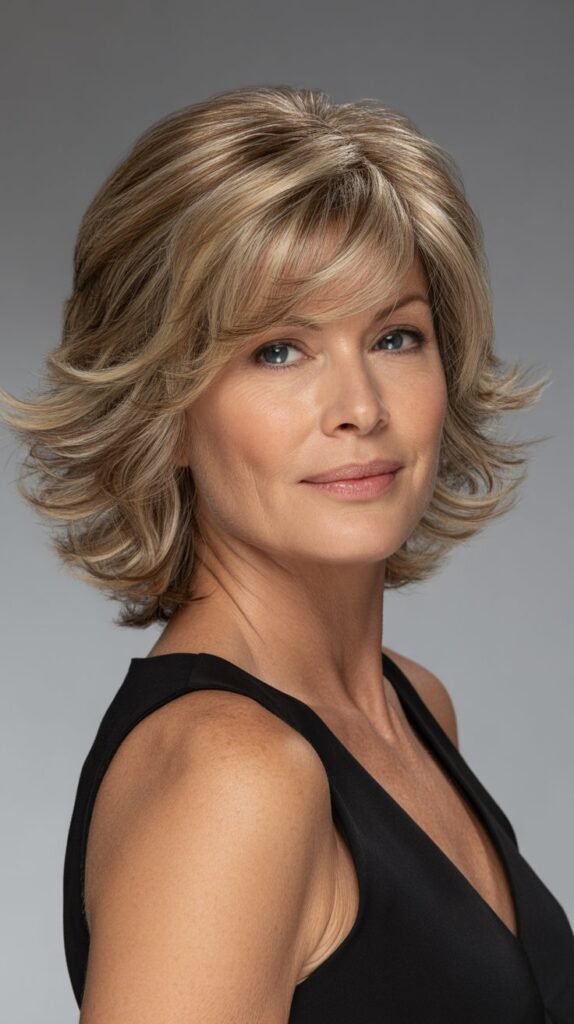
Layers work as the foundation for creating volume in thin fine hair, and when combined with side-swept bangs, this style delivers both fullness and face-framing elegance.
The strategic placement of layers removes weight from the ends while adding movement throughout the hair, making it appear significantly thicker.
Why This Style Works for Thin Fine Hair:
- The multiple layers create separation between hair strands, which generates the optical illusion of increased density and volume.
- Side-swept bangs draw attention to the eyes while softening facial features that may have become more angular with age.
- The length falling between the chin and shoulders provides enough hair to work with while preventing the dragged-down appearance that occurs with longer styles on fine hair.
- This cut requires minimal styling effort—simply blow-dry with a round brush directed away from the face for natural-looking body.
Styling Tips:
- Apply a volumizing mousse to damp hair before blow-drying to enhance lift at the roots.
- Use a 1.5-inch round brush to create subtle bends in the layers while drying.
- Finish with a light-hold hairspray to maintain movement without weighing down the hair.
- Consider adding babylights or highlights around the face to create additional dimension.
2. Textured Shag with Choppy Layers
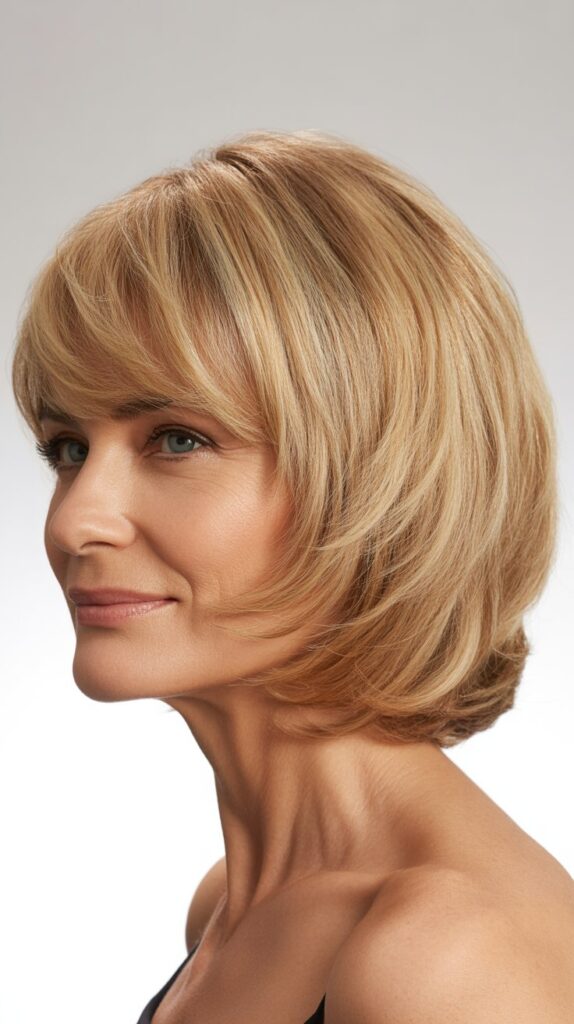
The modern shag has experienced a remarkable renaissance, and for good reason—it’s perfectly suited for adding texture and volume to thin fine hair through its signature choppy, piece-y layers.
This edgy yet sophisticated style brings youthful energy while addressing the specific challenges of aging hair.
Key Features:
- Choppy layers cut at varying lengths throughout the head create maximum texture and visual interest.
- The disconnected layering technique prevents thin hair from looking stringy or flat against the scalp.
- This style typically features shorter layers on top that gradually lengthen toward the bottom, building volume where it’s needed most.
- The shag works beautifully with natural texture, requiring less heat styling that can damage fragile fine hair.
Maintenance Requirements:
- Regular trims every 6-8 weeks maintain the choppy texture and prevent the style from losing its shape.
- A texturizing spray becomes your best friend for enhancing the piece-y, lived-in appearance.
- This cut air-dries beautifully, making it an excellent low-maintenance option for busy lifestyles.
- Adding subtle balayage or lowlights enhances the textured appearance by creating depth between layers.
3. Blunt Lob (Long Bob) with Subtle Layers

The blunt lob represents a masterclass in creating the appearance of thickness through strategic cutting techniques.
By maintaining weight at the perimeter while incorporating subtle internal layers, this style maximizes the fullness potential of thin fine hair.
Structural Benefits:
- The blunt perimeter line creates a solid foundation that makes hair appear denser and healthier at the ends.
- Internal layers hidden within the cut add movement without sacrificing the appearance of thickness at the bottom.
- The length typically falls between the collarbone and shoulders, which is the optimal zone for volume in fine hair.
- This versatile cut transitions seamlessly from professional settings to casual environments.
Styling Versatility:
- Blow-dry straight with a paddle brush for a sleek, polished appearance that still maintains body.
- Create loose waves with a 1.25-inch curling iron for added texture and dimension.
- The length provides enough hair to pull into a low ponytail or bun when needed.
- Adding face-framing highlights brightens the complexion while creating the illusion of more hair.
4. Wavy Medium Length Cut with Volume at Crown
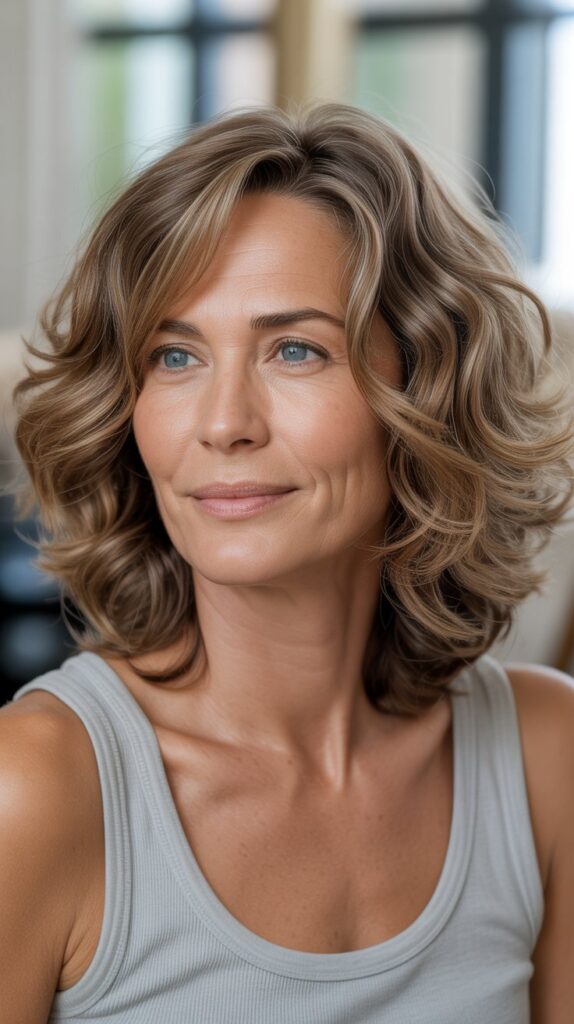
Creating height at the crown area strategically counteracts the flat appearance that commonly affects fine hair, especially as we age and hair loses its natural volume.
This style combines medium length with intentional wave patterns and crown elevation.
Volume-Building Techniques:
- Layers concentrated around the crown area provide lift where gravity typically causes thin hair to fall flat.
- Natural or styled waves add width and fullness throughout the mid-lengths and ends.
- The combination of height at the top and movement through the lengths creates balanced, proportional volume.
- This style works exceptionally well with slightly textured or wavy hair types that have natural bend.
Product Recommendations:
- Root-lifting spray applied at the crown before blow-drying creates lasting lift at the scalp.
- A volumizing powder or dry shampoo at the roots adds grip and texture for enhanced height.
- Sea salt spray on damp hair enhances natural wave patterns without adding weight.
- A lightweight finishing cream on the ends prevents frizz while maintaining the airy, voluminous appearance.
5. Angled Bob with Longer Front Pieces
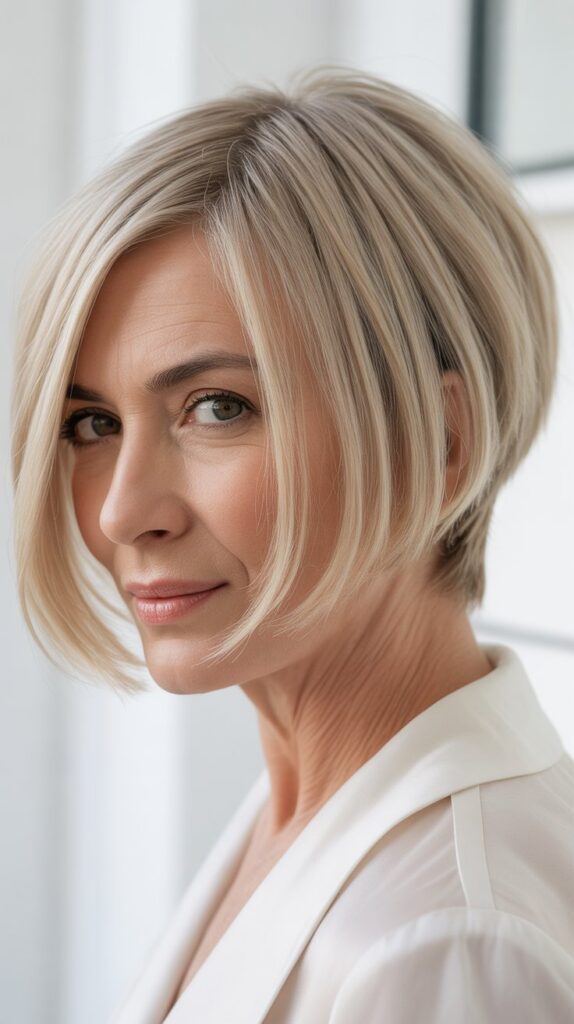
The angled bob creates visual drama through its graduated lengths that are shorter in the back and progressively longer toward the face.
This geometry naturally directs attention forward while adding body through its stacked layers.
Architectural Advantages:
- The shorter back section can be cut with stacked layers that build significant volume at the nape.
- Longer front pieces frame the face beautifully while creating the illusion of more hair due to the varied lengths.
- The angle draws the eye along the jawline, creating a flattering silhouette that complements mature facial features.
- This cut maintains a youthful, fashion-forward appearance while remaining age-appropriate and elegant.
Customization Options:
- The degree of angle can be adjusted from subtle to dramatic based on personal preference and face shape.
- Adding razored ends to the front pieces creates soft, feathered texture rather than blunt heaviness.
- Incorporating shorter layers throughout the back builds even more volume for extremely fine hair.
- Highlights concentrated on the longer front sections draw light and attention to the face.
6. Shoulder-Grazing Cut with Face-Framing Layers
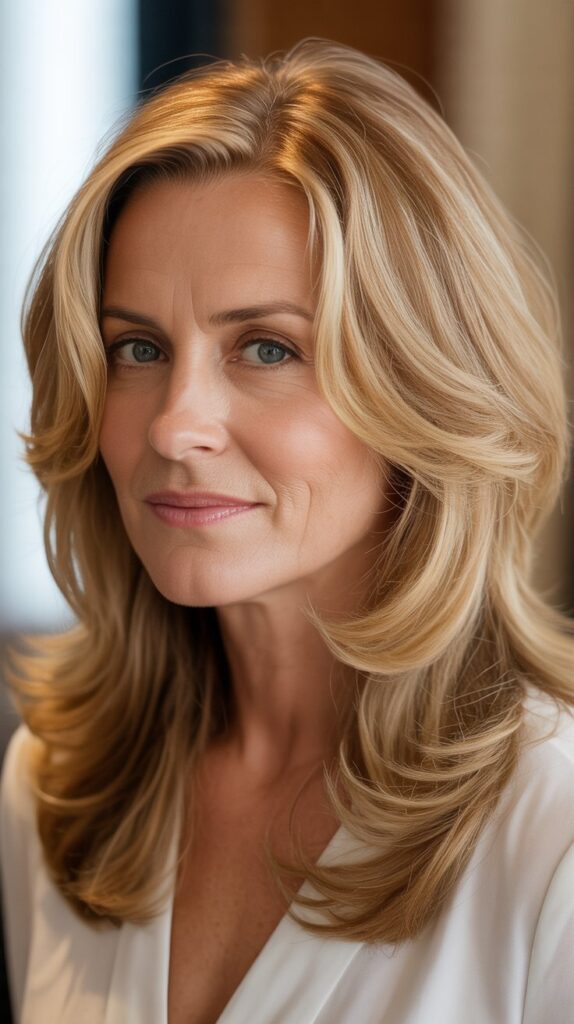
Shoulder-length hair provides an ideal balance between manageability and styling options, while face-framing layers specifically address the needs of mature faces and thin hair.
This classic combination delivers timeless elegance with modern functionality.
Face-Framing Benefits:
- Layers that begin at the cheekbone or jawline soften facial contours and draw attention to the eyes.
- The strategic placement of shorter pieces around the face creates dimension and depth that makes hair appear fuller overall.
- This style naturally falls away from the face, preventing the flat, heavy appearance that plagues one-length cuts on fine hair.
- The shoulder-grazing length is universally flattering and works with various hair textures and face shapes.
Styling Methods:
- A round brush blow-dry directed backward creates lift at the roots while the face-framing layers fall naturally forward.
- Loose curls focused on the mid-lengths and ends add body without creating the tight, dated appearance of over-curled hair.
- The length allows for versatile updos, half-up styles, and braids for special occasions.
- Balayage applied to the face-framing sections brightens the complexion and adds dimension.
7. Layered Cut with Curtain Bangs

Curtain bangs have surged in popularity because they offer the face-framing benefits of traditional bangs without the high-maintenance commitment or harsh line across the forehead.
Combined with layered medium length hair, this style creates multiple levels of volume and dimension.
Curtain Bang Characteristics:
- These bangs part in the center and sweep to each side, creating a soft, romantic frame for the face.
- The length typically grazes the cheekbones or jawline, which is particularly flattering for mature faces.
- Unlike blunt bangs, curtain bangs blend seamlessly into the rest of the haircut through gradual layering.
- The parted style adds width at the temples, balancing out facial features and creating the illusion of fuller hair.
Integration with Layers:
- Layers throughout the rest of the hair continue the movement established by the curtain bangs.
- The overall effect creates continuous flow from the bangs through the mid-lengths to the ends.
- This cohesive layering system prevents any one area from appearing too thin or sparse.
- The style works beautifully with natural texture or can be enhanced with styling tools.
8. Razored Medium Cut with Piece-y Texture

Razor cutting techniques create a different texture than traditional scissor cutting, producing softer, more feathered ends that add movement and reduce bulk.
For thin fine hair, this technique creates the appearance of intentional texture rather than sparse ends.
Razor Cutting Benefits:
- The razor creates tapered ends on each hair strand rather than blunt, uniform tips.
- This tapering allows hair strands to separate and move independently, creating more visual fullness.
- The piece-y texture adds a modern, effortless vibe that appears intentionally styled rather than accidentally thin.
- Razored cuts typically air-dry with more natural texture and movement than scissor cuts.
Maintenance and Styling:
- Razor cuts grow out more gracefully than blunt cuts, requiring less frequent salon visits.
- Texturizing products like sea salt spray or dry texture spray enhance the piece-y, separated appearance.
- Avoid heavy conditioners or oils that can clump the feathered ends together, negating the textured effect.
- This cut works exceptionally well for those embracing their natural hair texture with minimal heat styling.
9. Collarbone-Length Cut with Internal Layers
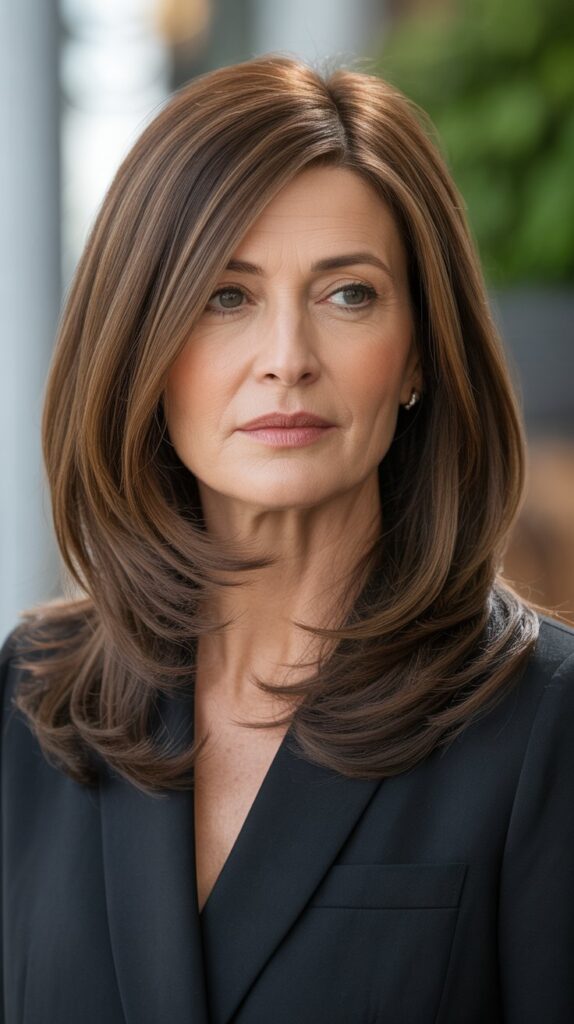
Internal layering represents a sophisticated cutting technique where layers are hidden within the haircut rather than visible on the surface.
This creates movement and reduces weight without sacrificing the appearance of thickness at the perimeter.
Technical Approach:
- The stylist removes bulk from the interior of the hair while maintaining length on the outer layer.
- This technique prevents the mushroom effect that can occur when heavy fine hair is cut to one length.
- Internal layers create air pockets within the hair that allow for better movement and body when styling.
- The outer layer remains relatively intact, giving the appearance of solid, healthy ends.
Ideal Candidates:
- This style works best for those with fine hair that still has some density, allowing for layer placement without creating visible gaps.
- Women who prefer a more polished, refined look rather than obviously layered, textured styles.
- Those seeking volume and movement while maintaining the ability to wear hair straight and sleek.
- Anyone who wants versatility to style hair both straight and wavy with equal effectiveness.
10. Medium Shaggy Cut with Wispy Ends

The shaggy cut with wispy ends combines multiple volume-creating elements: varied layer lengths, textured cutting techniques, and intentionally thinned ends that create airy, feathered movement.
This bohemian-inspired style adds youthful energy while addressing thin hair concerns.
Defining Features:
- Layers of different lengths throughout the head create maximum texture and separation.
- Wispy ends are achieved through point cutting or thinning shears, creating soft, feathered tips.
- The overall effect is casual, lived-in, and effortlessly chic rather than overly polished.
- This style embraces natural texture and requires minimal styling for a full, voluminous appearance.
Styling and Care:
- A texturizing spray or dry shampoo at the roots adds grip and volume for enhanced lift.
- Scrunch hair while air-drying or use a diffuser attachment to enhance natural waves and texture.
- The wispy ends benefit from light hydrating products rather than heavy creams that weigh them down.
- Regular trims every 6-8 weeks maintain the wispy texture and prevent the ends from appearing broken or damaged.
11. A-Line Bob with Graduated Layers
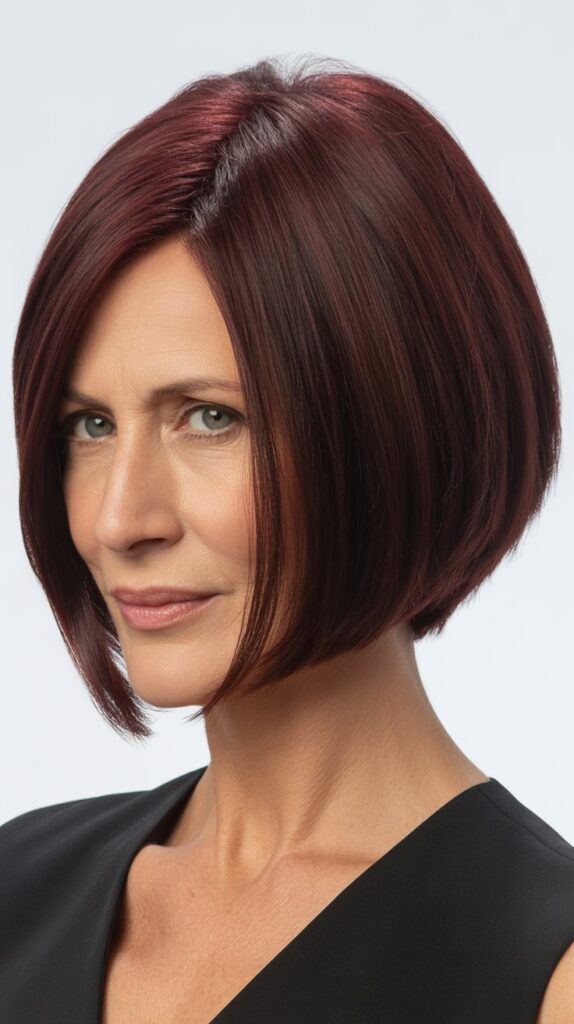
The A-line bob features a distinctive silhouette where hair is shorter at the back and gradually lengthens toward the front, creating an “A” shape when viewed from the side.
Graduated layers enhance this shape while building volume where it’s needed most.
Structural Elements:
- The shortest point at the nape can be cut very short and stacked to create maximum volume and lift.
- As the hair graduates forward, the increasing length creates a diagonal line that’s universally flattering.
- Layers throughout the cut prevent bulk while maintaining the overall A-line shape and movement.
- This geometric precision makes the style appear intentional and fashion-forward rather than thin.
Best Practices:
- This cut requires a skilled stylist who understands proper graduation techniques and angles.
- The style works best when blow-dried with a round brush, directing hair forward and under at the ends.
- Adding highlights or lowlights in vertical sections emphasizes the A-line shape and adds dimension.
- Regular maintenance every 5-6 weeks keeps the graduation precise and the shape intact.
12. Tousled Midi Cut with Beachy Waves
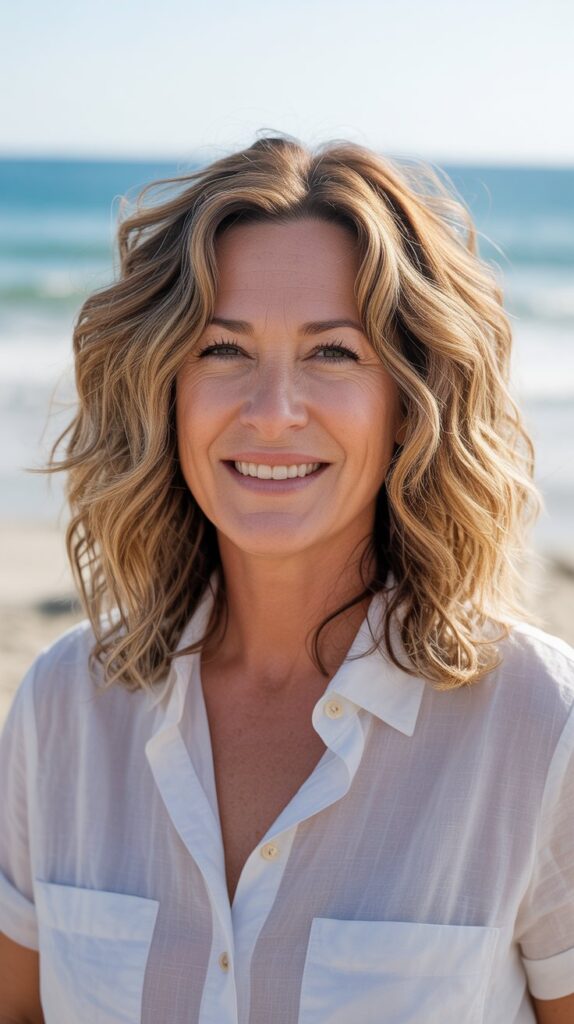
The midi length falls perfectly between shoulder and mid-back, offering enough length for versatility while avoiding the thinning appearance that can occur at longer lengths.
Beachy waves add crucial volume and texture to fine hair.
Wave Creation Techniques:
- Beachy waves are intentionally imperfect, with varied wave patterns that create the appearance of natural texture and fullness.
- Sea salt spray on damp hair enhances natural texture while adding the gritty, grippy quality that helps fine hair hold waves.
- A curling wand used with irregular sections and varied directions creates the random, natural-looking wave pattern.
- The tousled finish adds width and dimension that makes thin hair appear significantly fuller.
Lifestyle Benefits:
- This effortless style suits casual, active lifestyles while remaining polished enough for professional settings.
- The waves add body that lasts multiple days, reducing the need for daily washing and styling.
- Air-drying with styling products produces excellent results, minimizing heat damage to fragile fine hair.
- The midi length can be easily pulled into updos, ponytails, or braids without appearing skimpy.
13. Layered Cut with Swoopy Side Bang
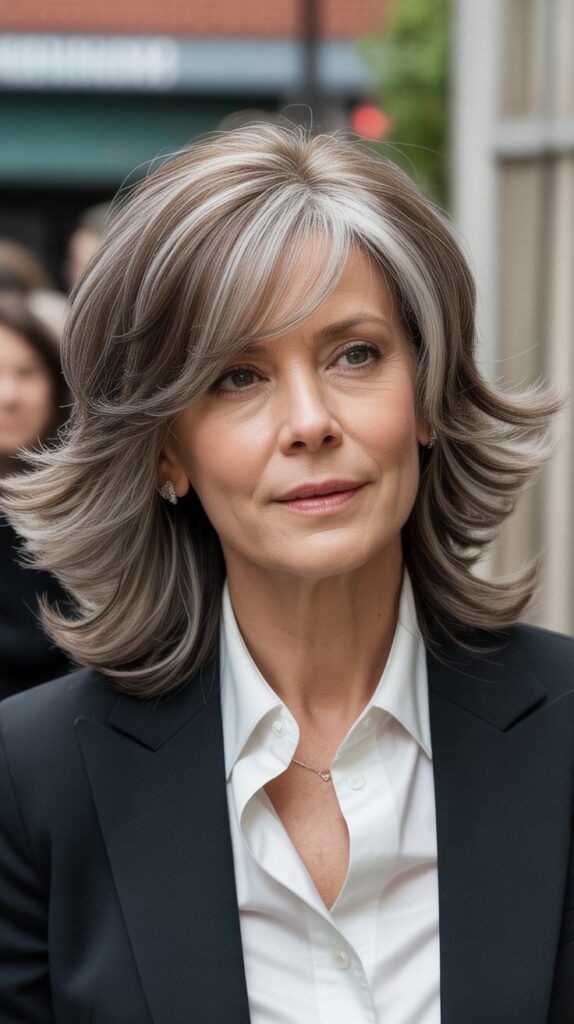
A swoopy side bang creates dramatic movement and draws attention to the eyes while adding asymmetrical interest to the overall style.
Combined with layers throughout medium-length hair, this creates multiple volume points.
Bang Characteristics:
- The swoopy bang sweeps across the forehead in a curved, flowing motion rather than falling straight.
- This movement adds volume at the front hairline, where thinning often becomes most noticeable with age.
- The length typically ranges from eyebrow to cheekbone, long enough to tuck behind the ear when desired.
- The asymmetrical placement prevents the harsh, heavy appearance of straight-across bangs.
Complementary Layering:
- Layers throughout the rest of the hair echo the movement established by the swoopy bang.
- The overall effect creates continuous flow and prevents any one area from appearing static or flat.
- This dynamic movement makes hair appear fuller through its constant motion and varied lengths.
- The style works beautifully with both straight and wavy textures, offering versatile styling options.
14. Textured Lob with Undone Ends
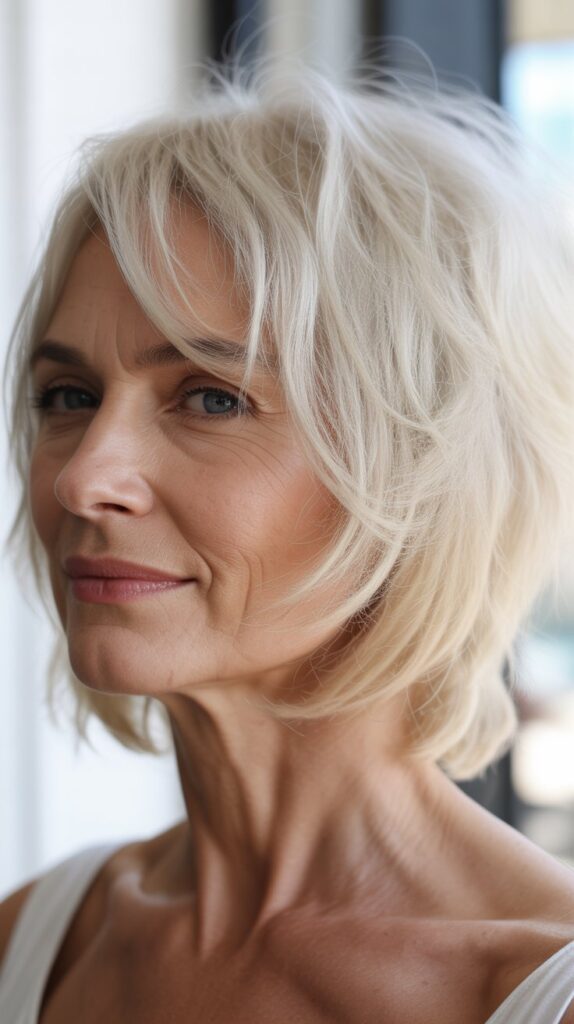
The undone, imperfect aesthetic has dominated modern hairstyling because it creates a relaxed, youthful appearance while disguising thin ends.
This textured lob combines perfectly imperfect styling with strategic cutting techniques.
Creating the Undone Look:
- Point cutting or slide cutting techniques create irregular, textured ends rather than a uniform line.
- The intentionally imperfect ends appear piecy and separated, disguising any natural thinness in the hair.
- Styling focuses on creating movement and separation rather than polished, uniform curls or waves.
- The overall effect is effortlessly chic, appearing as though you naturally woke up with perfect hair.
Styling Products and Methods:
- Texturizing sprays, dry shampoos, and styling powders add the gritty texture that creates separation.
- Avoid smoothing serums or heavy oils that clump hair together and reveal thinness.
- A curling iron used on random sections in varied directions creates the imperfect wave pattern.
- Finish by running fingers through hair to break up any uniform patterns and enhance the undone appearance.
15. Layered Flip with Outward Ends

The flipped-out ends style adds width at the bottom of the haircut, creating the appearance of fullness while delivering a playful, retro-inspired look.
This technique works particularly well for fine hair that naturally wants to flip outward.
Flip Technique:
- Using a round brush while blow-drying, the ends are directed outward away from the head.
- This creates width at the perimeter that makes thin hair appear more voluminous and intentionally styled.
- Layers throughout the cut enhance the flipped effect by creating multiple points of outward movement.
- The style works best on hair that falls between chin and shoulder length.
Modern Interpretation:
- Today’s version of the flip is subtler and more natural than the dramatic flips of past decades.
- The outward movement is typically concentrated on the bottom inch or two of hair rather than extreme flipping.
- Combining the flip with loose waves or slight texture modernizes the look and prevents a dated appearance.
- Strategic highlights on the ends draw attention to the flipped sections and enhance dimension.
16. Asymmetrical Medium Cut with Longer Side
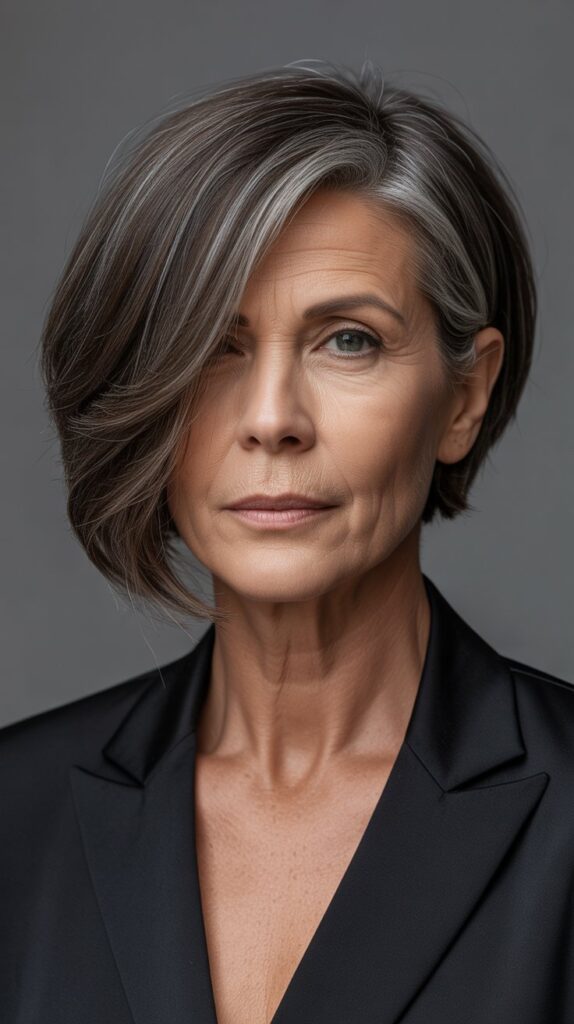
Asymmetry creates instant visual interest and makes thin hair appear intentional and fashion-forward rather than simply sparse.
This bold choice involves keeping one side noticeably longer than the other for dramatic effect.
Design Elements:
- One side typically falls at chin length or shorter while the other extends to shoulder length or beyond.
- The dramatic difference in lengths draws attention to the artistic cut rather than hair density.
- Layers on both sides create movement and texture that enhances the overall asymmetrical design.
- This style makes a confident statement and projects a modern, fashion-aware aesthetic.
Styling Considerations:
- The longer side can be styled with waves or curls for added volume and dimension.
- The shorter side works well when tucked behind the ear to emphasize the length difference.
- This cut requires commitment as growing it out involves an extended awkward phase.
- Regular maintenance trims are essential to keep the intentional asymmetry looking sharp rather than accidentally uneven.
17. Wavy Bob with Piecey Layers
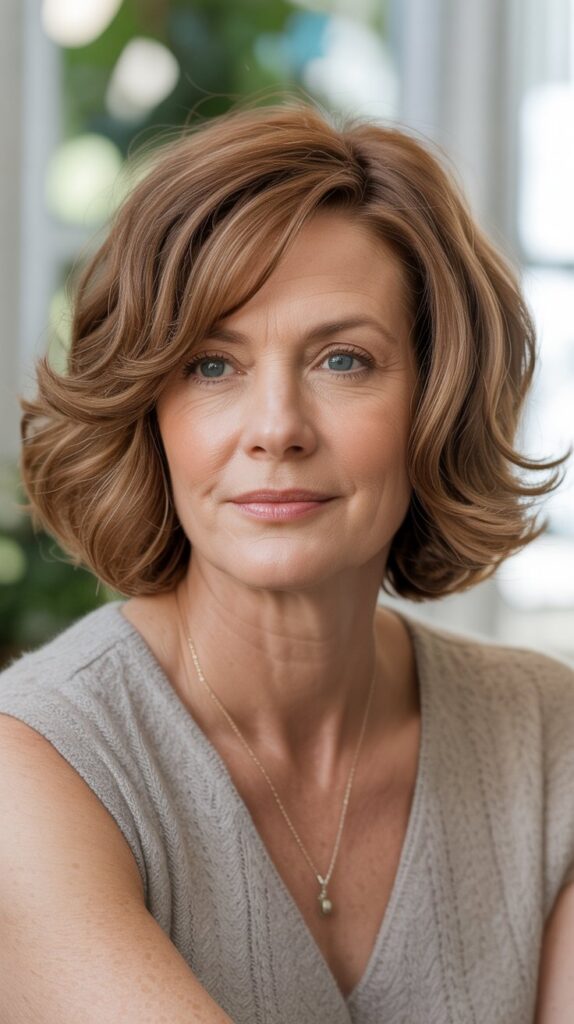
Combining the classic bob structure with wavy texture and piecey layers creates maximum volume and movement for thin fine hair.
This style delivers timeless elegance with modern texture techniques.
Layering Strategy:
- Piecey layers are cut throughout the bob to create separation between hair sections.
- The layers are typically shorter on top and gradually lengthen toward the bottom, building volume at the crown.
- Each piece moves independently, creating the illusion of more hair through multiplied movement points.
- The bob length keeps weight distributed evenly without pulling hair flat at the roots.
Wave Application:
- Waves add crucial width and dimension to the straight bob structure.
- The wavy texture prevents thin hair from lying flat or appearing limp throughout the day.
- Natural waves can be enhanced with styling products, or waves can be created with heat tools.
- The combination of waves and layers creates a dimensional, full-bodied appearance.
18. Medium Shag with Feathered Bangs
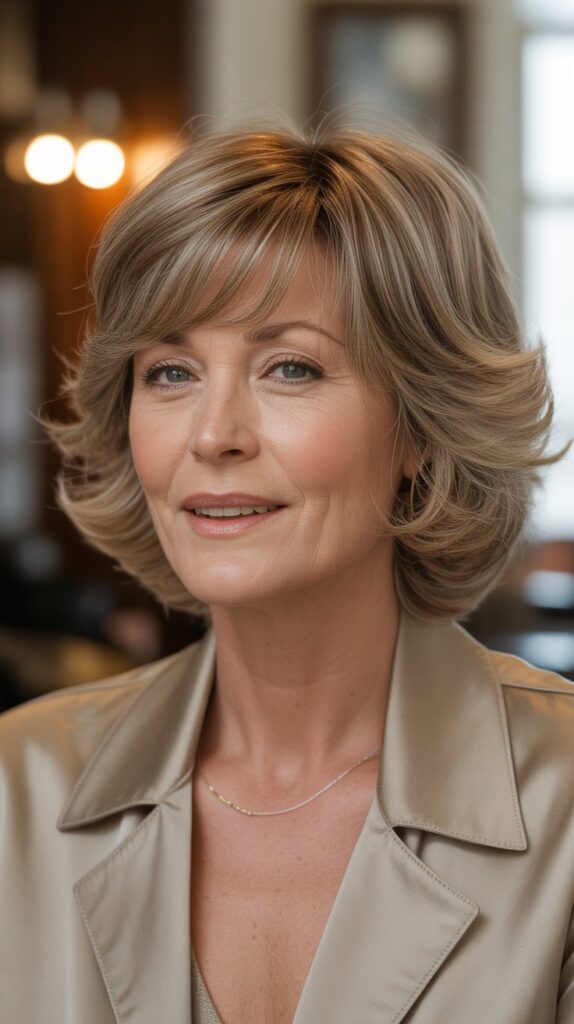
Feathered bangs paired with a medium shag create a cohesive, textured look that maximizes volume at the front hairline while maintaining fullness throughout.
This seventies-inspired style has been updated for modern sensibilities.
Feathering Technique:
- Feathered bangs are cut with a razor or point-cutting technique to create soft, feathered ends that fan across the forehead.
- The feathering creates separation and movement that makes fine hair appear fuller at the most visible area.
- These bangs blend seamlessly into the shaggy layers of the rest of the haircut without creating harsh lines.
- The overall feathered effect adds dimension and prevents fine hair from appearing flat or stringy.
Shag Body:
- The medium shag extends the feathered texture throughout the entire head for consistent volume.
- Multiple layer lengths create texture at every level from roots to ends.
- This style embraces natural texture and movement rather than requiring perfectly polished styling.
- Regular trims maintain the feathered texture and prevent the shag from appearing overgrown or shapeless.
19. Shoulder-Length Cut with Balayage Dimension

While balayage is a coloring technique rather than a cut, it deserves inclusion because strategic color placement creates the illusion of depth and fullness in thin fine hair.
Combined with a shoulder-length layered cut, the results transform flat hair into dimensional beauty.
Balayage Benefits for Thin Hair:
- The hand-painted highlighting technique creates natural-looking dimension with varied tones throughout the hair.
- Lighter pieces catch light and create the visual effect of more hair volume and movement.
- The dimension prevents thin hair from appearing one-dimensional and flat in color and texture.
- Balayage grows out gracefully without harsh regrowth lines, reducing maintenance requirements.
Color Placement Strategy:
- Concentrating lighter pieces around the face brightens the complexion and draws attention forward.
- Dimensional color throughout the lengths creates depth that makes thin hair appear fuller.
- Mixing multiple tones (highlights and lowlights) creates the most natural, voluminous effect.
- Working with a skilled colorist ensures proper placement that enhances rather than overwhelms fine hair.
20. Textured Medium Cut with Root Lift

Root lift techniques combined with a textured medium cut address the primary complaint of fine hair—flatness at the roots. This styling-focused approach creates lasting volume where it’s most needed.
Root Lifting Methods:
- Volumizing products applied directly at the roots before blow-drying create lasting lift.
- Blow-drying with a round brush held at the roots while directing heat upward builds volume.
- Root-lifting clips placed at the crown while hair dries train hair to stand away from the scalp.
- Backcombing or teasing at the roots adds temporary volume for special occasions.
Cut Design:
- Shorter layers at the crown provide less weight pulling down on the roots.
- The texture throughout the cut allows styled volume to hold rather than falling flat.
- Medium length provides enough hair for styling versatility without excessive weight.
- Strategic layering creates natural lift points that enhance styling efforts.
21. Angled Lob with Razored Ends
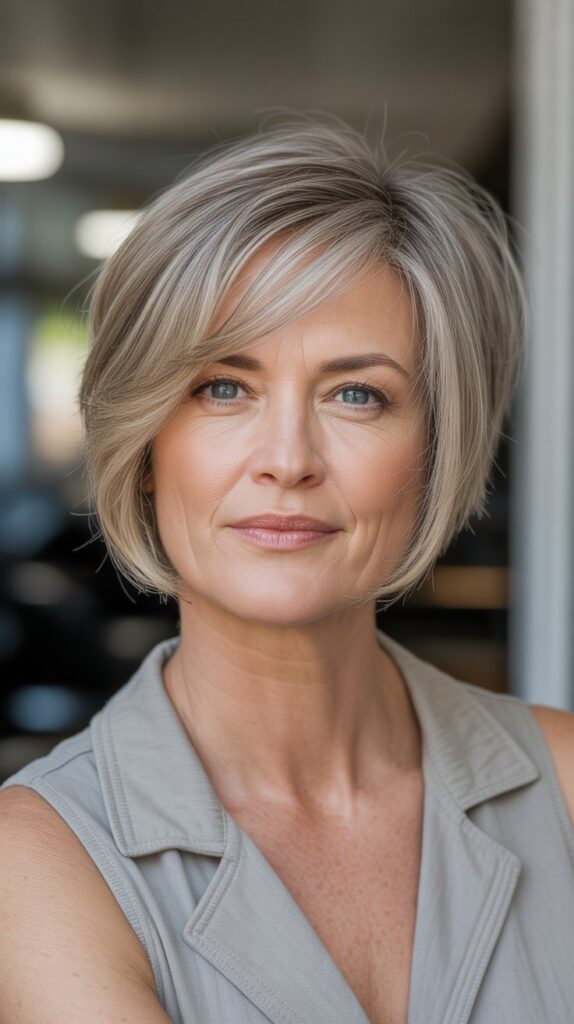
Combining the angled lob structure with razored end techniques creates a style that’s both architecturally interesting and texturally rich. This addresses multiple challenges of thin fine hair through strategic cutting approaches.
Structural Advantages:
- The angled length creates a forward-focused silhouette that frames the face beautifully.
- Shorter back sections can incorporate stacked layers for volume at the nape.
- The longer front pieces provide face-framing benefits while the varied lengths disguise thinness.
- The overall diagonal line creates visual interest that distracts from hair density concerns.
Razor Cutting Benefits:
- Razored ends create soft, feathered tips rather than blunt, heavy lines.
- This technique allows individual hair strands to separate and move independently.
- The textured ends appear intentionally piece-y rather than accidentally sparse.
- Razoring throughout the cut reduces bulk while maintaining the appearance of fullness.
22. Layered Cut with Highlights and Lowlights

The combination of highlights and lowlights creates multidimensional color that adds significant visual depth to thin fine hair.
When paired with strategic layering, this creates the most voluminous appearance possible.
Dimensional Color Theory:
Layering and Color Integration:
- Layers of different lengths showcase the varying color tones as hair moves and catches light.
- The dimensional color makes each layer more visible and distinct from others.
- Lighter tones on top layers and darker tones underneath create natural-looking depth.
- The interplay of light and shadow through movement makes thin hair appear significantly fuller.
Application Guidelines:
- Working with a skilled colorist ensures proper placement and tone selection for mature skin tones.
- Keeping contrast subtle (2-3 shades difference) creates the most natural, sophisticated effect.
- Maintenance typically requires touch-ups every 8-12 weeks depending on color choice.
- Glossing treatments between color appointments maintain vibrancy and shine.
23. Tousled Medium Length with Dry Texture
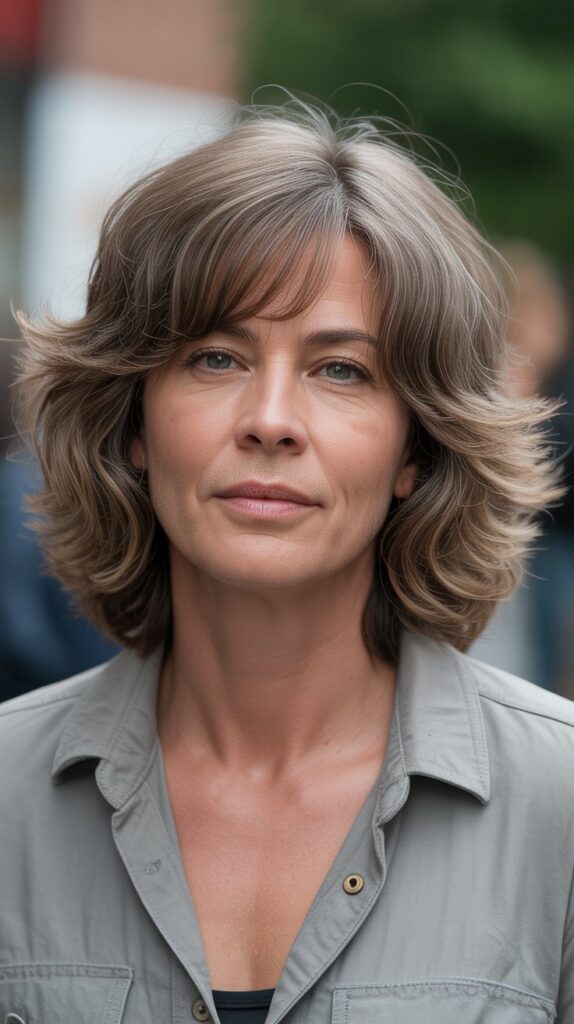
Dry texture styling has revolutionized fine hair styling by adding grip, separation, and volume without the weight of traditional styling products.
This approach creates an effortlessly cool, undone appearance.
Dry Texture Products:
- Texture sprays add gritty, matte finish that helps fine hair hold volume and style.
- Dry shampoos serve double duty by absorbing oil and adding volume-building texture.
- Volumizing powders applied at roots create lift that lasts all day.
- These products work by coating hair strands to increase diameter and create friction between hairs.
Styling Technique:
- Apply dry texture products to dry or nearly dry hair rather than wet hair for maximum effect.
- Focus application at the roots for volume and through mid-lengths for separation.
- Use fingers to scrunch and manipulate hair into desired shape rather than brushing through.
- The resulting style appears purposefully undone and texturized rather than styled and polished.
24. Collarbone Cut with Curved Layers

Curved layering follows the natural shape of the head, creating a rounded, full silhouette that’s particularly flattering for fine hair.
This technique builds volume through strategic layer placement.
Curved Layer Design:
- Rather than straight, linear layers, curved layers follow the contour of the skull.
- This creates a dome-like shape with fullness at the sides and crown.
- The rounded silhouette makes thin hair appear fuller by creating width rather than length.
- Layers curve around the face for flattering face-framing without harsh lines.
Proportional Balance:
- The collarbone length provides enough hair for the curved layers to create their full effect.
- Shorter lengths on top graduate smoothly into the longer collarbone length.
- The overall shape is balanced and proportional, avoiding the heavy-at-bottom look of one-length cuts.
- This cut works exceptionally well for those with round or heart-shaped faces.
25. Messy Bob with Intentional Imperfection
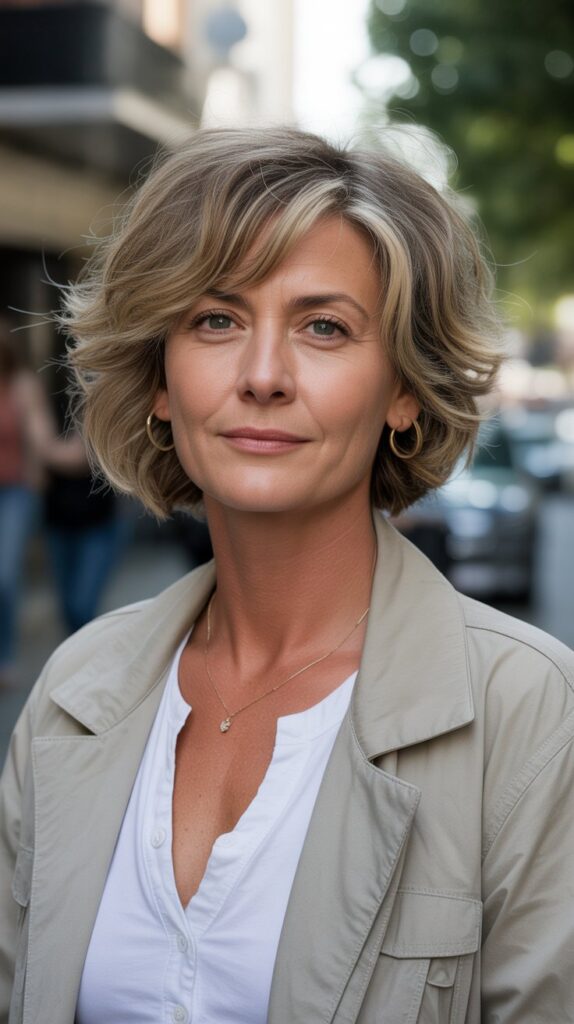
The messy bob embraces imperfection as a styling principle, which works brilliantly for thin fine hair by disguising sparse areas through strategic dishevelment and varied texture.
Messiness as Strategy:
- Intentional messiness creates visual confusion that makes it difficult to perceive thinness.
- Varied textures, directions, and separations create multiple focal points rather than uniform thinness.
- The undone appearance suggests fullness through its casual, I-didn’t-try-too-hard aesthetic.
- This style works with natural texture rather than fighting against it.
Creating Controlled Chaos:
- Start with a bob cut that has varied layer lengths and texturized ends.
- Apply styling products to enhance separation and piece-y texture.
- Use fingers to tousle and arrange hair in different directions rather than uniform styling.
- The key is creating intention behind the messiness so it appears styled rather than neglected.
26. Medium Length with Soft Graduated Bob

The soft graduated bob features gentle graduation from back to front rather than dramatic angles, creating subtle volume while maintaining a refined, classic appearance.
This timeless style suits conservative and professional environments.
Gentle Graduation:
- The length difference from back to front is typically 1-2 inches rather than dramatic angling.
- This creates shape and interest without the bold statement of sharply angled cuts.
- Soft graduation works particularly well for those transitioning from longer hair.
- The style maintains a classic, timeless aesthetic that won’t appear dated.
Sophisticated Styling:
- This cut looks polished when blow-dried smooth with subtle volume at the roots.
- A slight inward curve at the ends creates a sophisticated, finished appearance.
- The style works beautifully for professional settings, formal events, and mature aesthetics.
- Adding subtle highlights in natural tones enhances dimension without appearing trendy.
27. Choppy Medium Cut with Multiple Lengths
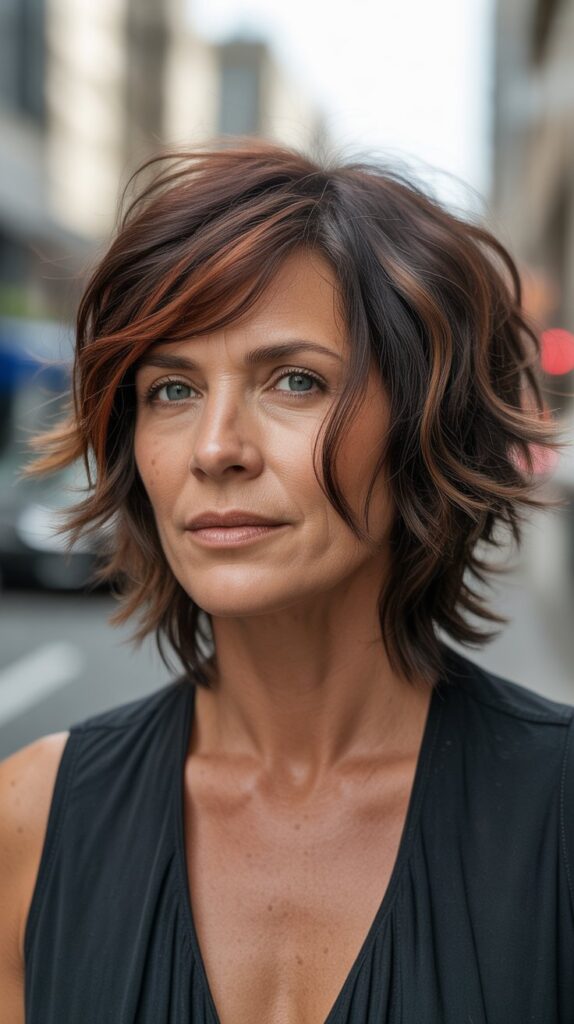
A choppy cut featuring multiple distinct lengths creates maximum texture and movement, addressing thin fine hair through varied visual interest at every level. This modern approach disguises thinness through intentional irregularity and dynamic styling.
Multiple Length Strategy:
- Different sections of hair are cut to varying lengths throughout the head, creating a staggered, layered effect.
- The irregular lengths prevent the eye from focusing on any single thin area.
- Each length moves independently, multiplying the appearance of volume through separated movement.
- The choppy texture adds edginess and contemporary style while serving the functional purpose of maximizing fullness.
Cutting Technique:
- Point cutting and slide cutting create the disconnected, choppy appearance between sections.
- Layers range from short pieces near the crown to longer pieces at the perimeter.
- The varied lengths work together to create an overall cohesive style despite the intentional irregularity.
- This technique requires a skilled stylist who understands texture and movement in fine hair.
28. Wavy Lob with Middle Part
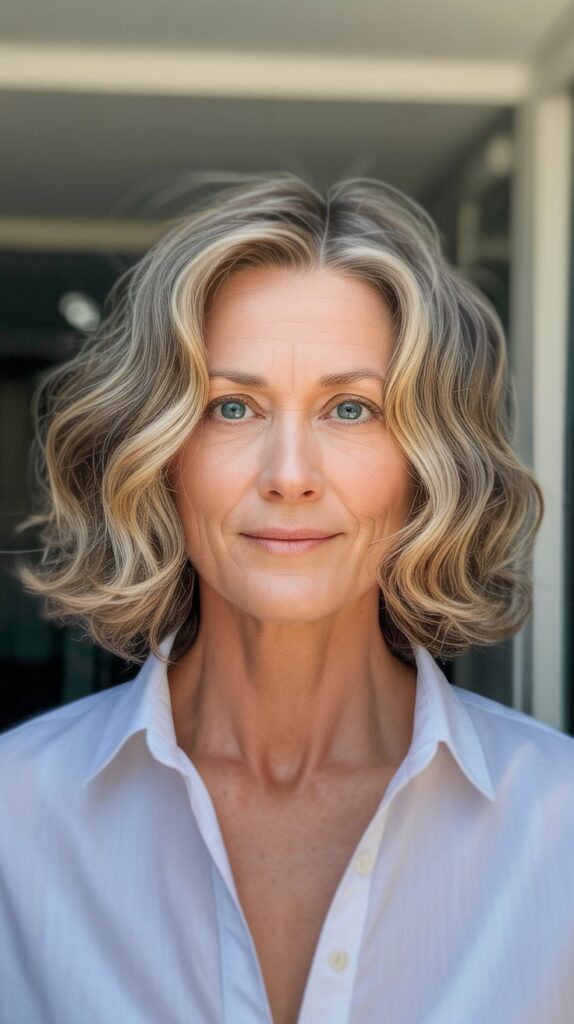
The middle part has returned to prominence, and when combined with a wavy lob, it creates symmetrical balance and volume on both sides of the face.
This classic styling choice suits fine hair beautifully.
Middle Part Advantages:
- The center part creates natural lift at the crown as hair falls away from the scalp on both sides.
- This parting distributes hair evenly, preventing the flat, heavy appearance that can occur with side parts on thin hair.
- The symmetrical styling creates balanced proportions and suits most face shapes.
- Middle parts work particularly well with wavy or textured styling that adds width.
Wave Integration:
- Waves starting at ear level add width and volume where hair naturally falls from the middle part.
- The wavy texture prevents thin hair from clinging to the head on either side of the part.
- Loose, relaxed waves create the most natural, voluminous appearance.
- The collarbone length combined with waves creates an effortlessly chic, balanced silhouette.
29. Textured Cut with Piecey Crown Layers

Focusing volume-building techniques at the crown addresses the most problematic area for aging fine hair—the top of the head where thinning becomes most noticeable. Piecey crown layers create strategic fullness.
Crown Layer Strategy:
- Shorter layers concentrated at the crown stand up and away from the scalp rather than lying flat.
- The piecey, separated texture of these layers creates visual fullness through multiplied movement points.
- Crown layers can be styled with volumizing products and directed upward for maximum lift.
- The shorter top layers graduate into longer lengths through the sides and back for balanced proportions.
Styling for Maximum Crown Volume:
- Apply root-lifting spray or volumizing mousse specifically at the crown before drying.
- Blow-dry crown layers upward and forward using a round brush for lasting lift.
- Backcombing or teasing the crown layers adds temporary volume for special occasions.
- Dry shampoo or texture powder at the crown maintains volume throughout the day.
30. Shoulder-Length with Side-Swept Volume
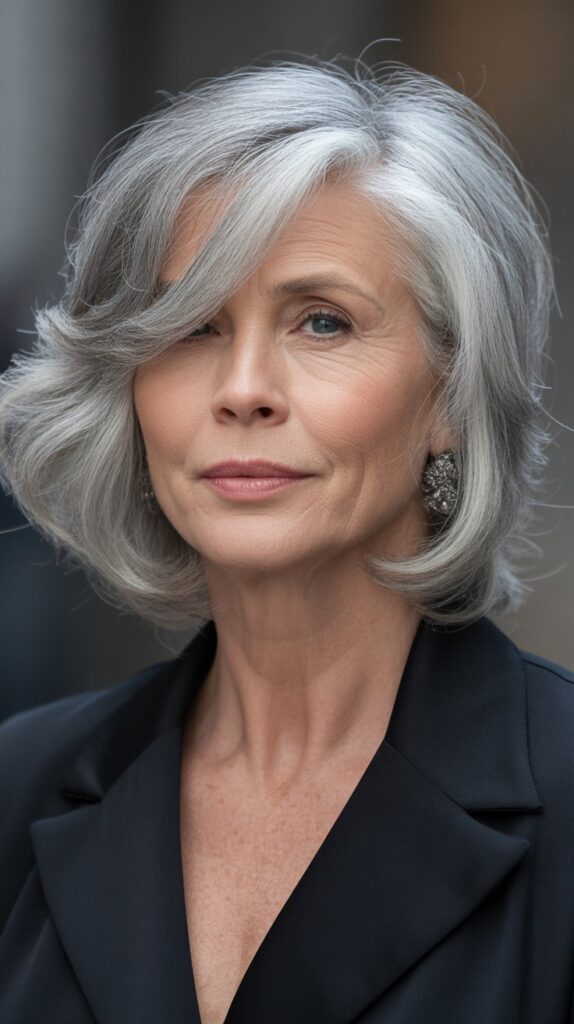
Side-swept styling creates asymmetrical volume and visual interest while addressing the flatness that plagues fine hair. This glamorous approach works beautifully for both casual and formal occasions.
Side-Swept Technique:
- Hair is dramatically swept to one side, creating volume through the gathering and directional styling.
- The side with more hair appears fuller due to the concentration of all hair in one area.
- The opposite side can be smoothed close to the head or tucked behind the ear for contrast.
- This styling approach instantly adds drama and sophistication to medium-length cuts.
Volume Creation:
- Volumizing products at the roots throughout help maintain the swept style’s lift.
- The hair on the fuller side can be curled or waved for additional texture and dimension.
- Bobby pins or styling clips secure the style while maintaining the appearance of effortless volume.
- This versatile styling works with various cuts and can be achieved on straight or wavy hair.
31. Layered Cut with Babylights Throughout

Babylights are ultra-fine highlights that mimic the natural dimensional color of children’s hair, creating subtle depth that makes thin fine hair appear significantly fuller through color variation.
Babylight Characteristics:
- These highlights are applied in hair-thin sections throughout the head rather than chunky foils.
- The fine sections create natural-looking dimension that catches light from every angle.
- Babylights blend seamlessly with base color, avoiding harsh contrast or striping effects.
- The multidimensional result makes each hair strand appear more visible and substantial.
Application for Fine Hair:
- Concentrating babylights on surface layers ensures maximum light reflection and visibility.
- The subtle color variation creates depth without the harsh regrowth lines of traditional highlights.
- This technique adds dimension without additional cutting or styling requirements.
- Maintenance is more manageable than traditional highlights due to the subtle, blended nature.
32. Medium Shag with Front-Focused Layers
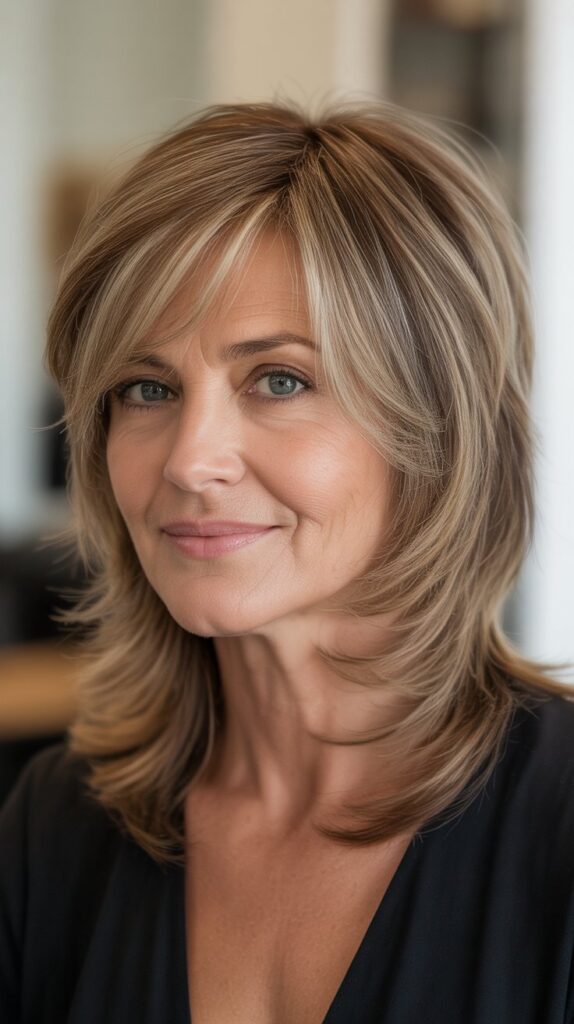
Concentrating shorter, textured layers at the front of the head creates maximum impact where hair is most visible while maintaining length and fullness through the back and sides.
Front-Focused Design:
- The shortest layers frame the face from the forehead through the cheekbones.
- These layers create movement and volume in the most visible area when viewing someone face-to-face.
- Back sections maintain more length and weight for overall fullness and styling versatility.
- The contrast between textured front and fuller back creates dimensional interest.
Styling Focus:
- Front layers can be blown dry with a round brush for volume or air-dried for natural texture.
- The face-framing pieces draw attention to facial features while adding width at the temples.
- Back sections can be styled straight, wavy, or in updos without affecting the front layers.
- This design allows for creative styling variations while maintaining consistent volume at the front.
33. Collarbone Cut with Flicked-Out Layers

Flicking layers outward creates width and fullness while adding playful movement to medium-length hair. This technique updates classic styling with modern texture and volume-building approaches.
Flick Technique:
- Using a round brush while blow-drying, ends are directed outward and slightly upward.
- This creates width at the perimeter that makes thin hair appear more voluminous.
- Multiple layer lengths create staggered outward flicks throughout the cut rather than just at the bottom.
- The flicked appearance adds energetic movement and youthful vitality.
Modern Application:
- Today’s flicked layers are softer and more natural than rigid retro styles.
- The outward movement is enhanced with texture sprays for a piece-y, modern finish.
- Combining flicked layers with loose waves creates contemporary dimension.
- Strategic highlights on the flicked pieces draw light and emphasize the outward movement.
34. Asymmetrical Lob with Textured Styling

An asymmetrical lob combines uneven lengths with textured styling for a bold, artistic statement that transforms thin fine hair into a fashion-forward masterpiece.
Asymmetrical Design:
- One side is cut noticeably shorter than the other, creating visual drama and interest.
- The length difference typically ranges from one to three inches for noticeable but wearable asymmetry.
- Layers throughout both sides create texture and movement that enhances the asymmetrical design.
- This bold choice projects confidence and style-awareness.
Texture Enhancement:
- Textured styling with products like sea salt spray emphasizes the piece-y, separated nature of the cut.
- The varied lengths work beautifully with tousled, undone styling approaches.
- Waves or curls can be concentrated on the longer side for additional impact.
- The asymmetry itself disguises thinness by creating such strong visual interest.
35. Medium Cut with Root-to-Tip Highlights

Root-to-tip highlights that start at the scalp and continue through the ends create maximum dimensional color throughout the entire hair shaft, multiplying the fullness effect through consistent light reflection.
Comprehensive Highlighting:
- Unlike traditional highlights that leave roots dark, these highlights begin at the scalp for all-over dimension.
- The consistent color variation from roots to ends creates continuous light reflection and depth.
- Multiple tones woven throughout make thin hair appear significantly fuller through color complexity.
- This technique brightens the overall appearance while adding crucial volume-enhancing dimension.
Maintenance and Care:
- Root-to-tip highlights require more frequent maintenance as regrowth becomes visible at the scalp.
- Touch-ups every 6-8 weeks keep the dimensional effect consistent and fresh.
- Purple-toning shampoos maintain cool blonde tones and prevent brassiness in highlighted sections.
- The dramatic dimensional effect makes the additional maintenance worthwhile for many women with thin hair.
Essential Styling Products for Thin Fine Hair Over 50
Selecting the right products makes a significant difference in achieving volume and fullness with thin fine hair. The following product categories address specific needs:
Volumizing Products:
- Mousse: Applied to damp hair before blow-drying, mousse adds body without weight and helps hair hold volume throughout the day.
- Root Lifting Sprays: These targeted products lift hair at the scalp where flatness is most problematic.
- Volumizing Powders: Applied at the roots of dry hair, these powders add instant lift and grip.
- Texture Sprays: Create separation and piece-y texture that makes thin hair appear fuller through visual complexity.
Styling Products to Avoid:
- Heavy oils and serums that weigh down fine hair and cause it to lie flat against the scalp.
- Thick, creamy leave-in conditioners that add too much weight to fragile strands.
- Strong-hold gels that clump hair together and reveal thinness rather than creating separation.
- Products with silicones that build up on fine hair and gradually diminish volume over time.
Professional Styling Tips from Expert Hairstylists
Experienced hairstylists who specialize in fine hair over 50 consistently recommend specific techniques that maximize volume and manageability.
Blow-Drying Techniques:
- Always blow-dry hair in the opposite direction from how it naturally falls to create lift at the roots.
- Use a round brush to create tension while drying, which adds body and smoothness simultaneously.
- Direct heat at the roots first before moving to mid-lengths and ends to establish volume at the foundation.
- Finish with a cool shot to set the style and add lasting shine without weighing hair down.
Strategic Product Application:
- Apply volumizing products only at the roots and mid-lengths, avoiding the ends which need less weight.
- Use minimal amounts of all products—fine hair requires less product than thick hair for optimal results.
- Layer products strategically: volumizing spray first, then mousse, then texture spray for maximum effect.
- Avoid applying conditioner at the roots, focusing only on mid-lengths and ends to prevent flatness.
Professional Treatments:
- Regular glossing treatments at salons add shine that makes thin hair appear healthier and fuller.
- Keratin treatments specifically formulated for fine hair can add body without weighing hair down.
- Scalp treatments that promote healthy hair growth may improve hair density over time.
- Consultation with a stylist specializing in fine hair ensures optimal cut and color choices for individual needs.
Hair Care Routine for Maintaining Volume and Health
Establishing a consistent hair care routine that addresses the specific needs of thin fine hair over 50 helps maintain optimal volume, health, and appearance between salon visits.
Washing Schedule:
- Avoid daily washing which strips natural oils and can make fine hair appear even thinner.
- A washing schedule of every 2-3 days allows natural oils to provide body while keeping hair fresh.
- When washing, focus shampoo on the scalp and roots rather than the lengths.
- Use lukewarm or cool water for the final rinse to help seal the hair cuticle and add shine.
Product Selection:
- Choose volumizing shampoos and conditioners specifically formulated for fine or thinning hair.
- Look for products with ingredients like biotin, collagen, and keratin that strengthen and thicken hair strands.
- Avoid heavy moisturizing formulas designed for thick or dry hair that will overwhelm fine textures.
- Consider clarifying shampoos used weekly to remove product buildup that weighs down fine hair.
Heat Protection:
- Always apply heat protectant spray before using blow dryers, curling irons, or flat irons on fine hair.
- Fine hair is more vulnerable to heat damage than thick hair and requires extra protection.
- Use heat tools on lower temperature settings when possible to minimize damage.
- Allow hair to air-dry partially before beginning heat styling to reduce overall heat exposure.
Lifestyle Factors That Affect Hair Health Over 50
Beyond styling and products, various lifestyle factors significantly impact the health, thickness, and appearance of hair, particularly for women over 50.
Nutritional Considerations:
Hormonal Considerations:
- Menopause and hormonal changes significantly affect hair density and texture in women over 50.
- Consulting with a healthcare provider about hormone replacement therapy may help address hair thinning.
- Thyroid imbalances can cause hair loss and should be evaluated if thinning accelerates suddenly.
- Stress management through meditation, exercise, or therapy can minimize stress-related hair loss.
Daily Habits:
- Gentle brushing with wide-tooth combs or soft-bristle brushes prevents breakage in fragile fine hair.
- Avoiding tight hairstyles like ponytails that create tension and potential hair loss at the roots.
- Sleeping on silk or satin pillowcases reduces friction and breakage compared to cotton.
- Regular scalp massage improves circulation to hair follicles, potentially supporting healthier growth.
Choosing the Right Stylist for Fine Hair
Finding a hairstylist who understands the unique challenges of thin fine hair over 50 makes an enormous difference in achieving optimal results and satisfaction with your hairstyle.
Questions to Ask Potential Stylists:
- What experience do you have specifically with fine or thinning hair on mature clients?
- What cutting techniques do you use to create volume in thin hair?
- How do you approach color for fine hair to enhance fullness without causing damage?
- Can you show me examples of your work with clients who have similar hair to mine?
Consultation Importance:
- A thorough consultation before any cutting or coloring allows discussion of goals, concerns, and realistic expectations.
- Bringing reference photos helps communicate your desired style but allows the stylist to adapt it for your specific hair.
- Honest communication about your styling routine and abilities ensures the recommended cut fits your lifestyle.
- A skilled stylist should explain why they’re recommending specific techniques and how they’ll benefit your hair.
Red Flags to Avoid:
- Stylists who dismiss your concerns about thinning hair or suggest inappropriate styles for fine textures.
- Anyone who pushes expensive treatments or products without explaining their specific benefits for your hair.
- Stylists who rush through consultations or seem unwilling to answer questions about their approach.
- Those who show limited portfolio work with fine hair or mature clients.
Budget-Friendly Alternatives to Salon Treatments
While professional salon services deliver optimal results, budget-conscious alternatives can help maintain your style between appointments and reduce overall costs.
At-Home Color Maintenance:
- Root touch-up products extend time between full color appointments by camouflaging gray regrowth.
- Purple-toning shampoos maintain blonde tones and prevent brassiness at a fraction of salon treatment costs.
- Semi-permanent glosses applied at home add shine and subtle color enhancement between professional services.
- Color-depositing conditioners gradually build color while conditioning hair.
DIY Volumizing Treatments:
- Homemade scalp scrubs using brown sugar and olive oil remove buildup and stimulate circulation.
- Apple cider vinegar rinses clarify hair and add shine without expensive salon clarifying treatments.
- Protein treatments using egg masks strengthen hair structure naturally.
- Scalp massage with fingertips for 5-10 minutes daily improves circulation without any cost.
Smart Shopping Strategies:
- Purchase professional-quality products in larger sizes online where they’re often discounted significantly.
- Subscribe to beauty supply store loyalty programs for regular discounts and points toward future purchases.
- Watch for seasonal sales at salons for discounted services like color or deep conditioning treatments.
- Consider cosmetology schools where supervised students provide quality services at reduced prices.
Adapting Your Style for Different Occasions
Medium-length hairstyles for thin fine hair offer remarkable versatility, easily adapting from casual daily wear to formal special occasions with appropriate styling adjustments.
Everyday Casual Styling:
- Air-dried with texture spray creates an effortless, low-maintenance look perfect for daily activities.
- A simple blow-dry with fingers rather than brushes produces natural volume without excessive styling time.
- Second-day hair refreshed with dry shampoo at roots provides easy volume and texture.
- Loose, undone waves created quickly with a curling wand add polish without appearing overly styled.
Professional Work Settings:
- Smooth blow-out with rounded ends creates a polished, professional appearance suitable for business environments.
- Low ponytails or buns styled with volume at the crown maintain professionalism while controlling hair.
- Sleek side-parted styles with subtle waves project authority and sophistication.
- Neat, well-maintained cuts without excessive texture or undone styling suit conservative workplaces.
Special Events and Formal Occasions:
- Defined curls or waves with more hold and structure create glamorous, camera-ready styles.
- Half-up styles with volume at the crown combine elegance with the face-framing benefits of down hair.
- Accessorizing with decorative clips, headbands, or hair jewelry adds special occasion glamour.
- Professional blow-outs with smoothing treatments create red-carpet-worthy shine and movement.
Embracing Gray Hair with Style
Many women over 50 choose to embrace their natural gray hair, and medium-length styles beautifully showcase silver, salt-and-pepper, and white tones while addressing thinness concerns.
Transitioning to Gray:
- Growing out gray hair involves an awkward phase that medium-length cuts help manage more gracefully than very short or very long styles.
- Strategic highlights that blend gray regrowth with remaining colored hair ease the transition period.
- Gradually lightening colored hair closer to your natural gray shade makes the transition less dramatic.
- Patience during the 12-18 month transition period results in stunning natural color.
Maintaining Vibrant Gray:
- Purple or silver shampoos prevent yellow or brassy tones that can make gray hair appear dull or dingy.
- Gray hair tends to be coarser and drier than pigmented hair, requiring more intensive conditioning treatments.
- Regular glossing treatments add shine to gray hair which naturally reflects less light than pigmented hair.
- Protecting gray hair from sun exposure prevents yellowing and maintains bright, clean silver tones.
Styling Gray Hair:
- Textured cuts and styling show off the dimensional nature of salt-and-pepper tones beautifully.
- The natural highlights created by mixed gray and pigmented hair eliminate the need for color enhancement.
- Modern, fashion-forward cuts prevent gray hair from appearing dated or aging.
- Proper skincare and makeup adjust to complement the cooler tones of gray hair for a cohesive, polished appearance.
Conclusion
Discovering the perfect hairstyle from these Top 30+ Medium Length Hairstyles for Thin Fine Hair Over 50 empowers you to embrace your hair’s unique characteristics while maximizing volume, movement, and style.
The journey through layered cuts, textured styles, strategic coloring, and specialized styling techniques reveals that thin fine hair offers tremendous potential for beautiful, age-appropriate styles that boost confidence and simplify daily routines.
Remember that the ideal hairstyle combines proper cutting techniques from a skilled stylist, appropriate products that enhance rather than weigh down your hair, consistent care routines that maintain hair health, and styling methods that work with your hair’s natural texture rather than against it.
Whether you choose a classic layered bob, a modern textured shag, an elegant lob with dimension, or any of the other stunning options explored in this guide, the key lies in selecting styles that make you feel confident, beautiful, and authentically yourself.
Embrace the versatility of medium-length hair, celebrate the wisdom that comes with age, and wear your chosen style with the confidence that comes from finding the perfect match for your thin fine hair over 50.
